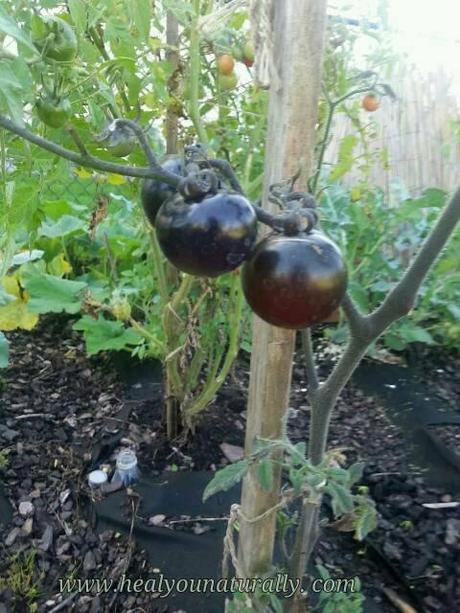
Anthocyanins: Protect cells and promote healing in the body, due to their high content of antioxidants- almost four times in some purple foods such as purple potatoes. Dr. Oz
Growing your own vegetables in a small garden is absolutely possible. I've been growing a garden for the past four years, in a community garden with limited space- my allocated space is about 8 x 8 or use a couple of boxes when other members aren't going to use them, and share the harvest if they'd like.
Last year I I had the fortune to find a rare but delicious kind of tomato, from a local organic farm- The indigo rose heirloom tomato. They start out green and gradually turn indigo-black.
Indigo Rose's genesis began in the 1960s, when two breeders - one from Bulgaria and the other from the United States - first crossed-cultivated tomatoes with wild species from Chile and the Galapagos Islands, Myers said. Some wild tomato species have anthocyanins in their fruit, and until now, tomatoes grown in home gardens have had the beneficial pigment only in their leaves and stems, which are inedible.
Its name is nothing scientific: Indigo= the color of its skin, and rose= the flesh.
The dark pigments responsible for the purplish tones are called anthocyanins, a type of phytonutrient, or plant compound, hailed for its potential disease-fighting benefits. Studies suggest anthocyanins might help reduce the risk of heart disease, diabetes and certain types of cancer. Some evidence indicates these purple pigments might protect our brains as we age.
Anthocyanins belong to the flavonoid family of plant compounds. They are among the most potent of all phytonutrients and have gained the attention of scientists worldwide.
The Indigo rose tomato kind was bred by Professor Jim Myers at the University of Oregon in the US and came about after a graduate student was interested in looking at health benefits in tomatoes. 'They found some tomatoes with purple pigmentation and tests revealed that anthocyanins were providing the color, the same as blueberries. 'They crossed the purple tomatoes with some wild tomatoes and eventually came up with a black strain.
What are Anthocyanins ~
Anthocyanins (Greek: ἀνθός (anthos) = flower + κυανός (kyanos) = blue) are in the class of flavonoids - compounds found in fruits, vegetables and beverages - that have aroused interest because of their potential health benefits. "They have many varied effects on human health, but while they are powerful antioxidants in the test tube, we don't really know whether they have an antioxidant effect in the human body."
Anthocyanin from pigments are responsible for the red, purple, and blue colors of many fruits, vegetables, cereal grains, and flowers. They have long been the subject of investigation by botanists and plant physiologists because of their roles as pollination attractants and phytoprotective agents.
Additionally, an interest in anthocyanin pigments has intensified today, because of their possible health benefits as dietary antioxidants. Over 300 structurally distinct anthocyanins have been identified in nature. Anthocyanins are one class of flavonoid compounds, which are widely distributed plant polyphenols. Flavonols, flavan-3-ols, flavones, flavanones, and flavanonols are additional classes of flavonoids that differ in their oxidation state from the anthocyanins. At least 5,000 naturally occurring polyphenolics have been identified, including over 2,000 flavonoids.
The polyphenolic profile of fruit juices is likely to include flavonols, free and esterified phenolic acids, and procyanidins. Polyphenolics contribute to food and beverage color by serving as substrates for an enzyme to produce brown pigments. The procyanidins and condensed tannins provide astringency and bitterness in tea and wine.
It is important to mention that these tomatoes are not GMO (genetically modified organism) or GE (genetically engineered). There is a big ddifferencebetween cross breeding and genitally modifying the seed.
In conclusion, I am not going to say that this is the only tomatoe I will grow from now on, because red tomatoes are equally delicious and nutritious. However, I have a different type of love for purple vegetables and fruits- yes even crossbreed. That being said, everything with pigment contains Anthocyanin so indulge in vegetables and fruits, even honey and some nuts have it.
As always thanks for reading and sharing the knowledge with friends and family, so they can too learn about foods rich in Anthocyanins. I learned a thing or two while researching as well. Don't ya love it?
Now you tell me. Have you tried a Rose Indigo or any of its variations and if so, how did you like it? Hopefully you will introduce more colorful veggies to your diet. I'd love to hear your experience in the comments below.To your best health,
 References: http://lpi.oregonstate.edu/ss01/anthocyanin.html http://www.dailymail.co.uk http://extension.oregonstate.edu/gardening/purple-tomato-debuts-indigo-rose Plum image by: www.sunipix.com
http://www.columbiatribune.com/arts_life/food/chefs-and-scientists-praistml
References: http://lpi.oregonstate.edu/ss01/anthocyanin.html http://www.dailymail.co.uk http://extension.oregonstate.edu/gardening/purple-tomato-debuts-indigo-rose Plum image by: www.sunipix.com
http://www.columbiatribune.com/arts_life/food/chefs-and-scientists-praistml
<A HREF="http://ws-na.amazon-adsystem.com/widgets/q?rt=tf_cw&ServiceVersion=20070822&MarketPlace=US&ID=V20070822%2FUS%2Fhealyocom-20%2F8010%2F46e5b485-a6b4-47c5-9338-8d1409645260&Operation=NoScript">Amazon.com Widgets</A>

